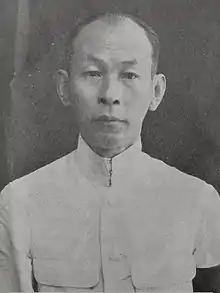People's Committee of Siam
The People's Committee of Siam, (Thai: คณะกรรมการราษฎร) was the first constitutional Cabinet of Siam (now Thailand) or (Thai: คณะรัฐมนตรีคณะที่ 1 ของไทย). After the Revolution of 1932, and promulgation of the 'Temporary' Constitution, Phraya Manopakorn Nititada (a civil servant and former Minister of Justice) was appointed the first President of the People's Committee (Thai: ประธานคณะกรรมการราษฎร) - in essence Prime Minister. However he was not allowed to appoint the members of the Cabinet as the Khana Ratsadon, the revolutionary party, has already decided to do that themselves.

Out of the fifteen members 10 are from the Khana Ratsadon; out of the 7 "Promoters" 5 are in the committee. The committee did not present any policies to the National Assembly, but decided to govern the country in accordance with the 6 Principles. The committee was active from 28 June 1932 to 10 December 1932. The committee ended with the signing and promulgation of the 'Permanent' Constitution of 1932, most members returned for the second Cabinet.[1]
| Title | Name | Party |
|---|---|---|
| President | Phraya Manopakorn Nititada | - |
| Member | Phraya Srivisaravaja | - |
| Member | Colonel Phot Phahonyothin | Khana Ratsadon |
| Member | Colonel Phraya Songsuradet | Khana Ratsadon |
| Member | Colonel Phraya Ritthiakhaney | Khana Ratsadon |
| Member | Phraya Phramuanwichapul | - |
| Member | Phraya Phrasasphithayayut | Khana Ratsadon |
| Member | Major Luang Phibunsongkhram | Khana Ratsadon |
| Member | Lt. Commander Luang Sinthusongkhramchai | Khana Ratsadon |
| Member | Phraya Phramuanwichapul | - |
| Member | Pridi Banomyong | Khana Ratsadon |
| Member | M.L. Dej Snidvongs | - |
| Member | Tua Lapanukrom | Khana Ratsadon |
| Member | Prayoon Pamornmontri | Khana Ratsadon |
| Member | Nab Phaholyothin | Khana Ratsadon |
See also
References
- "Archived copy". Archived from the original on 2008-12-16. Retrieved 2008-12-05.CS1 maint: archived copy as title (link)
